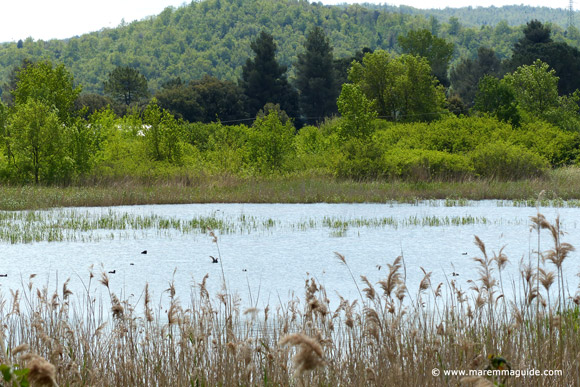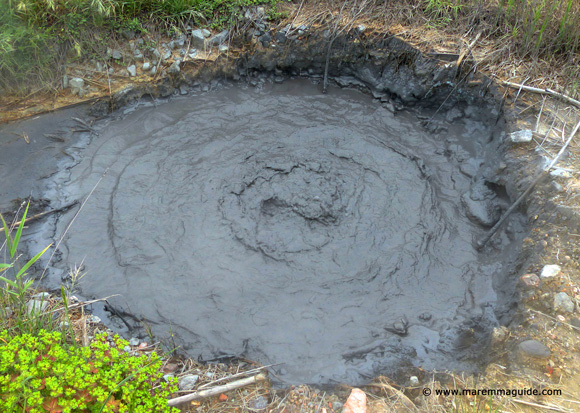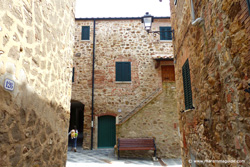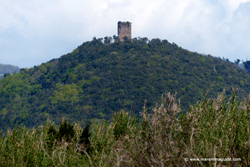Lago Boracifero
The Lago Boracifero in Maremma: one of those places on this earth that you are very unlikely to visit in your lifetime.
Unless you are a geothermal energy technician, a geologist on holiday in Maremma, or the curious type who ponders over a map of Tuscany whilst drinking a cappuccino or a glass of wine curious to know whether that loop of a white unmarked road visible on the map actually connects one road to another... Because if it does, it will considerably shorten your journey, but you won't tell your spouse that you aren't sure that it does before setting off! And, anyway, a "lago" sounds interesting, doesn't it...
 Lago Boracifero in the metalliferous hills - the "colline metallifere" - near Monterotondo Marittima in Maremma
Lago Boracifero in the metalliferous hills - the "colline metallifere" - near Monterotondo Marittima in MaremmaNow, to put it bluntly, although the lake is within the new Geothermal Park of Maremma and one of the world's largest geothermal fields and oldest centre of geothermal power production, there isn't much to see.
The "lago" is a small lake, but it is fenced-in all around its circumference, so you can't get any closer than this with a zoom lens. And the track that encircles it is closed-off in one place - you'll set many dogs off barking if you venture along it past the apartment blocks.
The hamlet - also now called Lago Boracifero, but once known by its full name of Villaggio Boracifero di San Federigo - is always closed-up. Built in the nineteenth century to provide accommodation for the workers engaged in the collection and trapping of steam at the lake and surrounding geothermal area to convert into electricity, they are now home to less than fifty people.
Apart from at the energy plant, I have only ever seen one parked car and one person on foot each time I have visited or driven through.
BUT, there is this! which makes it all the worthwhile to stop if you are en route to Lustignano or the castle of Castelluccio di Cornia. For you will will need to take the road from the centre of the hamlet anyway to reach them if you are heading that way from the south and Suvereto.

Warning: if you don't have the faintest interest in geology or things volcanic, don't bother, and miss the place altogether. But I do!
When you are in the centre, take the track to the power plant and stop just after the only house on the right, just before the entrance to the plant. The rising steam will give away it's exact position.
Marvellous mudpot! - the video
And whilst a toddler might look at this wonder with glee - oh, how little ones love playing with water and mud! - this one is fenced off for your own safety. After all, the mud is made by superheated water.
This mudpot lets off a lot of sulphurous gases! the smell of which aren't inducive to making you want to stay that long and it is wise not to to keep your camera lens uncovered for too long.
TIP
I didn't realise until playing-back at home the video footage I took that my camera constantly trying to re-focus when each surge of gas wafted in front of it. So if you want to capture a great shot or some video, best bet is to take a lot of frames.
What's a mudpot?
For mum's and dad's: I'm including this info as it should be just enough to give you time to take some photos or your own video before you get asked, "when are we going?"!
A mudpot is just one of Maremma's many fumaroles - locations in this geothermal landscape from which sulphurous and other gases emerge at pressure. In this case, the gases are escaping in a wet and muddy situation, making the mud bubble and spit and spurt.
The muddy location is all the responsibility of tiny 3.5 billion year old - the oldest micro-organisms on our planet - anaerobic bacteria living in the geothermal landscape who love to "eat" smelly gas: hydrogen sulphide. They obtain their energy to live by converting it into sulphuric acid. And it is that sulphuric acid which in turn decomposes the local rocks into fine clay particles.
Where gaseous natural hot springs - those with very little water - emerge within the rocks that have been eaten by the acid, the clay is turned into gloopy mud and mudpots are formed.
If the underlying water table levels are very low the viscosity of the mud will be very thick and sticky. When it is like that and there is sufficient stinky gas escaping from underground, those gases can cause the mud make huge blobs that explode!
Mud spewed out that plops around the brim of the pot can build up over time forming what looks like a mini volcano.
Most mudpots are the a white or grey colour like this one, but sometimes they can be stained a pink or red colour from iron compounds present in the local rocks. They are then known as paint pots!
Lustignano and the Castelluccio di Cornia
Both the tiny nearby hill top village of Lustignano and the ruins of the castle of Castelluccio di Cornia in the woodlands of the Val di Cornia are wonderful places nearby to visit and explore.
There is a small children's playground just as you enter the village that makes for a perfect place for a picnic stop.


Explore some more...
















